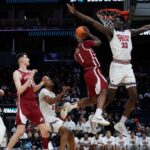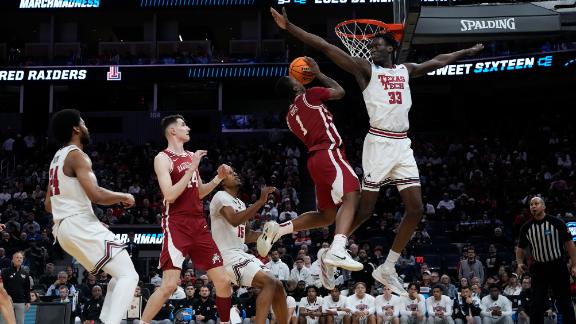Well, that stunk.
Every Arkansas fan went into this game thinking that this was just gravy. Win or lose, a Sweet Sixteen marks a successful season. There will be no disappointment. While in the grand scheme, that’s still true, the emotions changed a little bit when Arkansas led by 16 with 10 minutes to play. Just close it out, and another Elite Eight awaits.
I tend to be sort of a sore loser. My first instinct is rarely to give credit to an opponent when my team blows a winnable game. I wrote a baseball piece after Arkansas’ loss to Ole Miss in Omaha a couple years ago expressing frustration at the “you’ve gotta tip your cap” mentality when Arkansas’ offense gets shuts down in an elimination game, as it so often does.
But this time? That was just really well done by Texas Tech. Tip your cap. Tech played really, really hard and the Hogs were bit by a nasty regression to the mean on shooting percentages (for both teams) over the final 10 minutes. They still could’ve held on to win, but some unfortunate shot selection and a missed free throw let the Red Raiders force overtime.
Four key factors
Four things drove this loss, in my observation.
Regression to the mean. If the Razorbacks built their 16-point lead through domination of the paint, I don’t think this lead gets blown. But when Arkansas led 61-45 with 10 minutes to play, they had been outscored there. The lead happened because they had hit 8 3-pointers, and that’s just not sustainable with how this team plays. The Hogs would only make one 3-pointer the rest of the way, and they never did have a ton of success in the paint. Tech, an elite 3-point shooting team, was 3 of 21 at one point but hit 5 of their final 11 attempts.
Tech on the glass. Arkansas missed Adou Thiero in the second half of this game. Tech came in top-15 nationally in offensive rebound rate, and the Red Raiders finished with 22 offensive rebounds. That makes 50 allowed over Arkansas’ final two games. Arkansas’ shooting defense was excellent, hence all the misses, but the Hogs couldn’t finish the possession. Aidoo could have been better, but Brazile is not a disciplined rebounder on defense, while Thiero is. Arkansas couldn’t use its size on the glass because Tech was able to get in position.
Tech’s collapsing defense. Although Tech struggled on offense at times with Arkansas’ size, Tech’s defense was able to make up for its lack of size by collapsing everything when the ball went inside the arc. It wasn’t a zone, but it had the same effect on Arkansas’ driving guards. Tech rotated the low man (usually JT Toppin or Federiko Federiko) to stand under the basket and contest everything, allowing them to block six shots despite being the smaller team. Arkansas shot just 44% in the paint.
There are ways to punish a collapsing defense. The best way is to be very good at passing under the basket. Watch Alabama’s Mark Sears and you’ll see what I mean. When Sears drives to the basket, he’ll lay it up if there’s no rim protector, but if there is, he’s elite at finding someone nearby who can score before the tall defenders can get turned around. Unfortunately, Arkansas has no Mark Sears (very few teams do!), so DJ Wagner, Johnell Davis, and Billy Richmond were just not able to find a trailing Jonas Aidoo or Trevon Brazile.
Another way is to play inside-out and get the catch-and-shoot 3-point game going. Arkansas did successfully sneak shooters into the corner several times against the collapse, but they couldn’t hit the shot. Brazile missed a couple of wide-open corner 3s on this type of look. Karter Knox hit one with 1:30 left to make it 72-66, but that was about all the damage the Hogs were able to do there. Arkansas’ lack of catch-and-shoot 3-point threats was easily the biggest missing piece to the offense this year, and something John Calipari and staff have to fix this offseason.
The final way to attack a collapsing defense is the ol’ Eric Musselman strategy: send tall guards barreling into the lane looking to initiate contact. Muss’s teams were great at getting to the free throw line and mucking up a game. Calipari does not like mucking up games and that’s just not how he coaches (probably because that doesn’t really work in the NBA, despite what Shai Gilgeous-Alexander’s critics claim). Case in point is Wagner: over his final two games, he was 8 of 24 inside the arc with one trip to the free throw line. That’s a horrible ratio, and he was like that all year. He gets bumped a lot, but he makes so much effort to contort his body and avoid fouls that he never gets a friendly whistle. Arkansas could have won this game at the free throw line; instead, they had to deal with their own shooting regression.
Major mistakes late. Tech’s comeback caused this team to seize up, which is unfortunate, because despite everything else, the Hogs still had plenty of chances to win without Tech ever having a chance.
Here were the biggest mistakes:
- 3:02 2nd (69-61): Wagner follows up an excellent offensive rebound by Brazile by immediately shooting a 3-pointer with 19 seconds on the shot clock. The shot was open, and a make probably seals the game, but he’s not a good 3-point shooter and running more clock would’ve been the better option.
- 1:15 2nd (72-66): Davis secures a defensive rebound, but just holds the ball and gets tied up immediately. The possession arrow favors Tech, who immediately hits a 3. Again, a 30-second possession here by Arkansas probably seals the game. The official was really quick to call a jump ball, but Davis looked like he didn’t expect the defense to be all over him, which is definitely a mistake.
- 0:27 2nd (72-69): Aidoo misses the front end of a 1-and-1. That’s obviously a killer, as just one make probably ends it, as future free throws would be shot by Davis or Wagner, who are very good at the line.
- In the final shots of both regulation and overtime, Wagner’s decision-making was poor. At the end of regulation, shot almost goes in, but Wagner could have easily initiated more contact since his primary defender was on his hip. The shot at the end of overtime was just horrible. The ball should not have been in Wagner’s hands that long: I would have been more willing to live with Davis 3-point tries in both of those spots. He hits just 1 of 2, the Hogs win.
I didn’t really anything that Calipari did to choke this game away from a game management perspective. Arkansas definitely didn’t shut down offensively and try to take the air out of the ball: again, had they done that (Wagner doesn’t shoot that 3 so quickly), they probably win.
Ultimately, Arkansas had a bad shooting regression, struggled on the defensive glass, lacked the personnel to deal with Tech’s gambling, aggressive defense, and then made a handful of mental mistakes in the closing minutes. It stinks, but that happens sometimes.
- Box Score Breakdown: Texas Tech 85, Arkansas 83

- Matchup Analysis: 3 Texas Tech

- Box Score Breakdown: Arkansas 75, St. John’s 66

Advanced stats

With an average lead of 7.6 points, this was Arkansas’ best performance of the tournament, if you ignore how it ended. Both teams ended up taking their time in halfcourt, mostly because both defenses took away easy looks.

We mentioned in the preview that Tech’s transition defense was a weakness, so only 18 points on 17 transition possessions is really disappointing. The Hogs were bad in transition in all three NCAA Tournament games, which is interesting because Calipari’s last few Kentucky teams also struggled in transition in March. There may be something about the way he’s coaching his guards that causes them to play cautiously when they have a chance to run.

This is where the game was lost. Only one fastbreak point, outscored 18-3 off turnovers, and outscored 50-30 in the paint. In hindsight, if you change the order of the plays in this game, Arkansas was lucky to be in this game. If you told me beforehand that the Hogs would allow 50 points in the paint, I’d assume they got blown out.
I do think Aidoo did a fine job matching Toppin man-to-man, given how good Toppin is. The issue was that Brazile had no hope of corralling Darrion Williams (who was sensational), and the Hogs just couldn’t secure defensive boards.

That’s two games in a row where the Hogs allowed just way too many shots. Tech created 119 shots per 100 possessions, which is just too much to allow to a good-shooting team.
Calipari said after the St. John’s game, “if they make a few shots they probably win.” That’s basically what happened here. Tech didn’t shoot well, but they eventually made a few shots because Arkansas kept letting them have shots.

Tech outshot the Hogs in the paint, 54% to 44%. That’s the ballgame. Arkansas ended up with a slightly better overall effective field goal percentage (49% to 46%), but Tech won on pure volume of shots taken. Given how well they shot from 3, the Hogs could’ve closed this thing out with just an average performance in the paint.

Williams was plus-11 for Tech in 38 minutes, so the Red Raiders were outscored by nine in the seven minutes he was on the bench. Elijah Hawkins had an abysmal game (credit mostly goes to Wagner for good defense), but enough other guys stepped up. Toppin got going late once Tech got him on the move instead of trying to back down Aidoo.

Arkansas’ bench was hideous in this game. Davis, Knox, and Brazile were all positive in terms of plus-minus, but the Hogs lost when they came out. Boogie Fland struggled, and Thiero offered almost nothing in his return. Richmond didn’t look great but did collect three rebounds.
The numbers on Aidoo versus Big Z are interesting. Z was actually plus-6. He did not look impressive to me while watching, so I’d have to rewatch his possessions to see if an argument can be made that he should’ve played more.
What’s next?
As we’ve discussed before, this wasn’t Calipari’s best job in terms of roster construction, although he did a great job developing this team during the season. Now as the offseason begins, the Hogs need to build a better roster.
Arkansas has a 5-star point guard and 5-star shooting guard incoming in Darius Acuff and Maleek Thomas. Both are very strong, naturally-talented scorers who work best with high usage and the ball in their hands. Arkansas still needs a high-scoring forward, but one thing they didn’t have this year was a “sniper”: a low-usage, high-efficiency shooter who is dangerous on catch-and-shoot opportunities. I also think defensive rebounding has to be a priority. The Hogs ended up ranking 40th in the nation in defensive rebounding rate, which isn’t bad, but if they want to build a Final Four team, they have to be able to shut down small, aggressive, rebound-seeking teams like St. John’s and Texas Tech.
We’ll probably have a post in the coming days evaluating transfer portal targets and looking at missing pieces on the roster.

This was a painful loss. Thanks for putting it together. It’s nice to see some level headed discussion on what happened.
Your point on Big Z was interesting, because he did seem like a net positive while watching the game. He defended (decently) and his threat of being a 3 point shooter provided some spacing and opened it up on the inside. I thought the move-counter-move of Federiko and Big Z was kind of useful in the first half, but was probably overshadowed by Arkansas being hot from 3.
I think something that’s not mentioned is Tech taking advantage of us switching. They basically started having Williams get switches and play in the post. That last possession is a clear representation. I don’t think Brazile and Knox needed to switch. That was not a great screen set.
Good point. However, I didn’t think we did too badly when a guard switched onto Williams or Toppin. Our help side defense was generally there in time to contest the shot well and recovered well enough for kickout threes. As much credit as Williams has gotten, he was 8/26 on the night and was held in check for much of the game.
On another note, would be curious to see what the math is behind Game Score. It kind of checks with what I saw last night, but would be curious to see what goes into it.
Additionally, I think it’s also worth delving into individual player metrics, like xRAPM vs PORPOGATU (or equivalent). Seems like xRAPM (or any modified plus/minus stat) tends to value a lot of low usage high efficiency guys (seems like that generally leans towards wings), where as PORPOGATU (or any modified points/wins over replacement stat) generally values guys with larger usages (generally guards or bigs that get the ball fed to them).
I thought (and this is just feels, no data backup) that Tech turned the game when they went twin bigs in the second half with Toppin and Federicko.